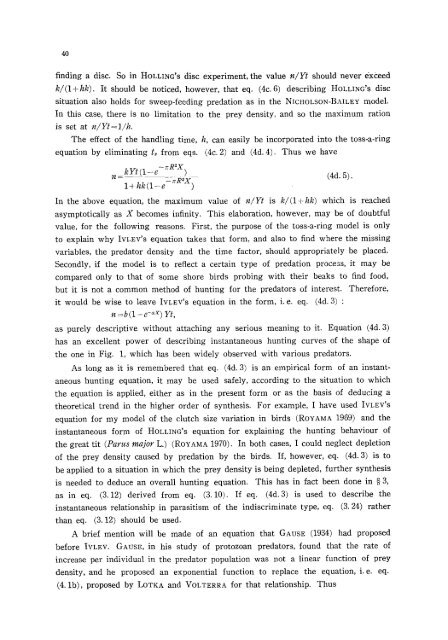A comparative study of models for predation and parasitism
A comparative study of models for predation and parasitism
A comparative study of models for predation and parasitism
Create successful ePaper yourself
Turn your PDF publications into a flip-book with our unique Google optimized e-Paper software.
40<br />
finding a disc. So in HOLLING's disc experiment, the value n/Yt should never exceed<br />
k/(l+hk). It should be noticed, however, that eq. (4c. 6) describing HOLLING'S disc<br />
situation also holds <strong>for</strong> sweep-feeding <strong>predation</strong> as in the NICHOLSON-BAILEY model.<br />
In this case, there is no limitation to the prey density, <strong>and</strong> so the maximum ration<br />
is set at n/Yt~l/h.<br />
The effect <strong>of</strong> the h<strong>and</strong>ling time, h, can easily be incorporated into the toss-a-ring<br />
equation by eliminating t~ from eqs.<br />
kYt(l_e -~R2X)<br />
n=l + hk(l_e- ~R2x )<br />
(4c. 2) <strong>and</strong> (4d. 4). Thus we have<br />
(4d. 5).<br />
In the above equation, the maximum value <strong>of</strong> n/Yt is k/(l+hk) which is reached<br />
asymptotically as X becomes infinity. This elaboration, however, may be <strong>of</strong> doubtful<br />
value, <strong>for</strong> the following reasons. First, the purpose <strong>of</strong> the toss-a-ring model is only<br />
to explain why IVLEV'S equation takes that <strong>for</strong>m, <strong>and</strong> also to find where the missing<br />
variables, the predator density <strong>and</strong> the time factor, should appropriately be placed.<br />
Secondly, if the model is to reflect a certain type <strong>of</strong> <strong>predation</strong> process, it may be<br />
compared only to that <strong>of</strong> some shore birds probing with their beaks to find food,<br />
but it is not a common method <strong>of</strong> hunting <strong>for</strong> the predators <strong>of</strong> interest. There<strong>for</strong>e,<br />
it would be wise to leave IVLEV's equation in the <strong>for</strong>m, i.e. eq. (4d. 3) :<br />
n = b (1 - e -~x) Yt,<br />
as purely descriptive without attaching any serious meaning to it. Equation (4d. 3)<br />
has an excellent power <strong>of</strong> describing instantaneous hunting curves <strong>of</strong> the shape <strong>of</strong><br />
the one in Fig. 1, which has been widely observed with various predators.<br />
As long as it is remembered that eq. (4d. 3) is an empirical <strong>for</strong>m <strong>of</strong> an instant-<br />
aneous hunting equation, it may be used safely, according to the situation to which<br />
the equation is applied, either as in the present <strong>for</strong>m or as the basis <strong>of</strong> deducing a<br />
theoretical trend in the higher order <strong>of</strong> synthesis. For example, I have used IVLEV'S<br />
equation <strong>for</strong> my model <strong>of</strong> the clutch size variation in birds (RoYAMA 1969) <strong>and</strong> the<br />
instantaneous <strong>for</strong>m <strong>of</strong> HOLLING'S equation <strong>for</strong> explaining the hunting behaviour <strong>of</strong><br />
the great tit (Parus major L.) (ROYAMA 1970). In both cases, I could neglect depletion<br />
<strong>of</strong> the prey density caused by <strong>predation</strong> by the birds. If, however, eq. (4d. 3) is to<br />
be applied to a situation in which the prey density is being depleted, further synthesis<br />
is needed to deduce an overall hunting equation. This has in fact been done in w 3,<br />
as in eq. (3. 12) derived from eq. (3.10). If eq. (4d. 3) is used to describe the<br />
instantaneous relationship in <strong>parasitism</strong> <strong>of</strong> the indiscriminate type, eq.<br />
than eq.<br />
(3.12) should be used.<br />
(3. 24) rather<br />
A brief mention will be made <strong>of</strong> an equation that GAUSE (1934) had proposed<br />
be<strong>for</strong>e IVLEV. GAUSE, in his <strong>study</strong> <strong>of</strong> protozoan predators, found that the rate <strong>of</strong><br />
increase per individual in the predator population was not a linear function <strong>of</strong> prey<br />
density, <strong>and</strong> he proposed an exponential function to replace the equation, i.e. eq.<br />
(4. lb), proposed by LOTKA <strong>and</strong> VOLTERRA <strong>for</strong> that relationship. Thus















